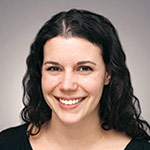From the Managing Editor
Step by Step for Science
A few years back, while pregnant with my first child, I visited Associate Professor of Biology Cara Wall-Scheffler’s lab in Eaton Hall once a month, as a participant in one of her studies. She had me put on a heart rate monitor, a vest, and a breathing mask that made me sound like Darth Vader in “Star Wars.”
Then I’d walk on the treadmill at four different speeds, while a small camera videotaped my feet in motion. The mask recorded how much energy I burned while walking at different speeds. While I rested in an office chair with my feet up between bouts of walking, we chatted about pregnancy, campus happenings, and our shared appreciation for the Pacific Northwest Ballet.
An expert in human evolution and physiology, Wall-Scheffler was studying the walking speeds of pregnant women. She wanted to know how pregnant women’s bodies adapt to conserve energy as their babies grow bigger and heavier.
Several years on, she has presented her findings and written up the data in a paper currently under peer review. Once published, the study will become part of a larger body of work by Wall-Scheffler and her Seattle Pacific University students that examines how humans have adapted to use energy in different scenarios.
If, like me, you get your science mostly from news headlines, you might think that scientists are always shouting “Eureka!” about discoveries that some common food (usually coffee or chocolate) either causes or prevents cancer. And one of Wall-Scheffler’s published studies on human locomotion actually did make worldwide headlines, when she observed that men slow their walking speed to walk with women they love.
But since participating in the pregnant walking study, I’ve been struck by how different the everyday work of research is from how it is reported in the news. Research is slow and patient observation, gathering and analyzing data about something as ordinary as walking, which advances our knowledge and reveals broader truths about our bodies and about our world.
In this issue of Response, we’re showcasing some exciting developments at Seattle Pacific. We have a new strategic plan to set us on a course for the future. As part of this plan, SPU faculty are delving into the scholarship of teaching in ways that increase students’ learning. They’re using innovation and technology, but applying it wisely, not just “throwing things at the wall to see what sticks,” as one professor put it. Meanwhile, as another part of the plan, years of intentional thinking and planning are reshaping how students live and grow alongside each other in community.
All this is new and exciting. At the same time, it’s step-by-step change, measured in increments that might not seem all that dramatic when viewed up close. We remain rooted in place, but we’re in a city that’s growing fast. Our vision of engaging the culture and changing the world hasn’t changed, nor has our commitment to the Christian faith — but the new students who arrive each fall give new life and new expression to that faith and commitment as they study and engage big questions.
Wall-Scheffler is now studying whether men and women carry loads differently when they walk. Whether this study makes headlines or not, it’s contributing to science, to human flourishing, and to a larger body of knowledge, step by step.
 Hannah Notess
Hannah Notess
